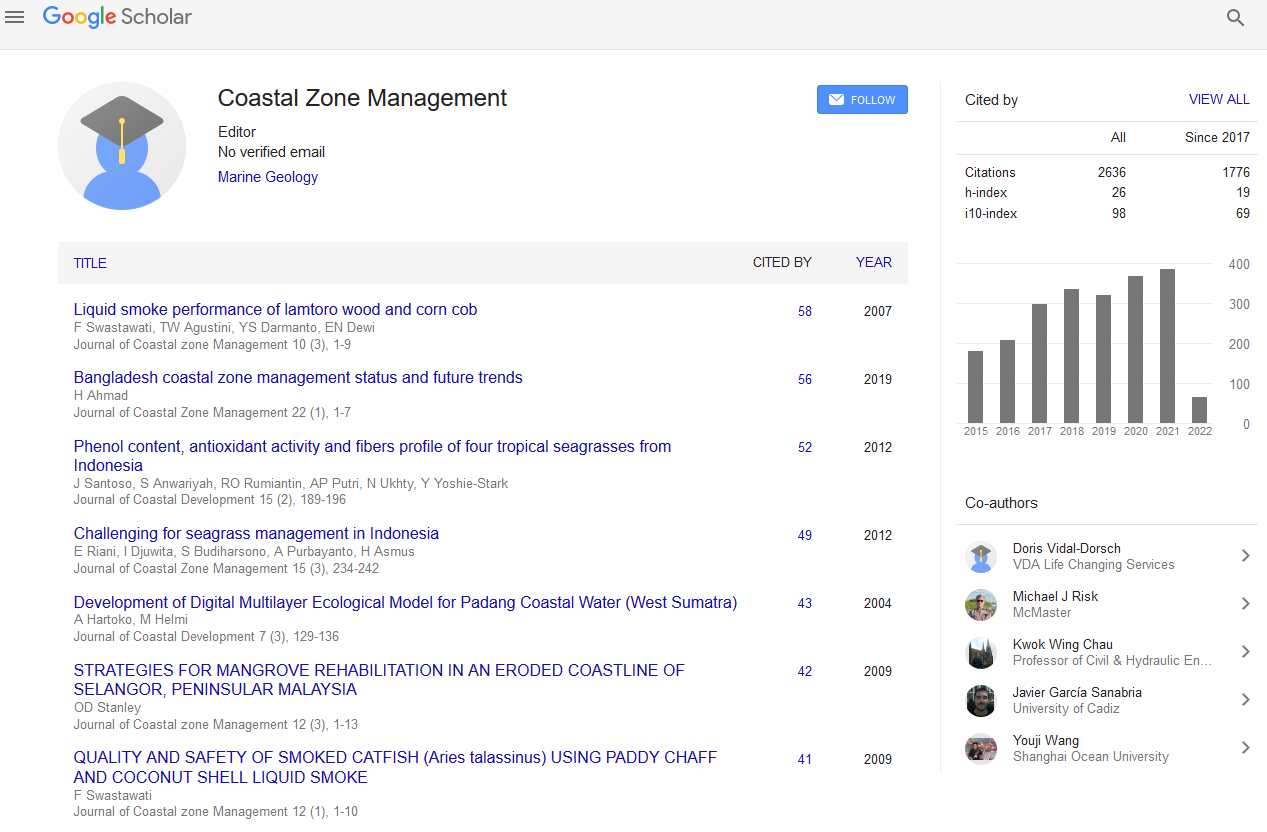Indexed In
- SafetyLit
- RefSeek
- Hamdard University
- EBSCO A-Z
- OCLC- WorldCat
- Publons
Useful Links
Share This Page
Journal Flyer

Open Access Journals
- Agri and Aquaculture
- Biochemistry
- Bioinformatics & Systems Biology
- Business & Management
- Chemistry
- Clinical Sciences
- Engineering
- Food & Nutrition
- General Science
- Genetics & Molecular Biology
- Immunology & Microbiology
- Medical Sciences
- Neuroscience & Psychology
- Nursing & Health Care
- Pharmaceutical Sciences
Past behaviors and future coastal defense options
2nd International Conference on Coastal Zones
July 17-18, 2017 Melbourne, Australia
Jose Simao Antunes do Carmo
University of Coimbra, Portugal
Keynote: J Coast Zone Manag
Abstract:
In the (recent) past, coastal works were generally of an engineering nature. The concept in force until the 1980s was to ensure safety at any cost. The issues were addressed and solved in an essentially physical context. At that time, an engineer took full responsibility for analyzing the coastal issue, producing the project, conducting the work and supervising its implementation. On the other hand, much of the engineering used in coastal projects was based on experience which , in combination with engineering practice, was a real rule of thumb. In this context, the combined effects of flood defences, protection of urban fronts, protection of heritage and reclamation of degraded areas have resulted in many kilometres of sea banks, sea walls and groin fields. It is known that hard engineering structures can be highly effective when used properly, but they can be overcome by events beyond their design capacity. Such structural measures also transfer the risk of erosion and possible flooding, reducing the risk in one location but increasing the risk in another. Moreover, investment and monitoring costs are high and monitoring is constantly required, and the beach aesthetics are lost. Meanwhile, following the evolution of computing means, it became possible to use increasingly sophisticated mathematical models to solve increasingly complex problems, allowing the generalization of the essentially ad hoc practices of engineering projects. Scientifically developed hydrodynamic theories were adopted and adapted to the basic principles of physics that could be used to generalize traditional practices. On the other hand, today, concerns are no longer limited to safety: lifestyle and quality of life have become essential ingredients. Other aspects of the project have also become important, such as environmental impact, attractiveness and sustainability. We may learn from the past that most adaptation measures have been more reactive than proactive. Today we know that adopting a passive attitude and simply reacting to events often leads to worse and more expensive solutions.
Biography :
Jose Simao Antunes do Carmo has completed his MSc in Hydraulics and Water Resources in 1990 from University of Lisbon and his PhD in Engineering Sciences in 1995 from University of Coimbra, Portugal. He has been the Director of several degree and master courses in Civil Engineering and Environmental Engineering in the period 1995-2010. He is Co-Editor of the International Journal of Integrated Coastal Zone Management and Editorial Board Member of the Ocean & Coastal Management. He has published over three dozen papers in ISI/WoS journals; two dozen papers in Portuguese scientific journals and over one hundred publications in international conferences. He is author of two books: “Modeling in Fluvial Hydraulics and Environment” and “Physical Processes and Computational Models in Coastal Engineering” and Co-Editor of three books: “Wastewater Treatment”, “River Basin Management III” and “Water Pollution VIII: Modeling, Monitoring and Management”. His main scientific areas of research are hydrodynamics, morphodynamics, coastal management, coastal processes, climate change and water quality.
Email: jsacarmo@dec.uc.pt

